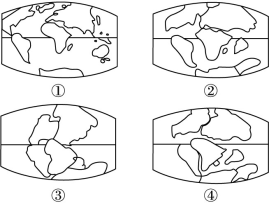问题
综合
德国科学家魏格纳提出了大陆漂移说,下列是不同时期大陆分布示意图,读图完成下列问题。

小题1:以上哪一幅图表示的是现代大陆的分布状况?( )。
A.①
B.②
C.③
D.④小题2:下列事实中,可以作为大陆漂移说证据的是( )。
A.陆地主要分布在北半球
B.世界陆地轮廓都比较破碎
C.大西洋两岸古老地层的相似性
D.我国东部海域发现古河流的遗迹小题3:地球科学研究表明,大陆漂移的原因是( )。
A.陆地上大量的水土流失
B.岩石圈板块的运动
C.火山和地震
D.全球气候的变化
答案
小题1:A
小题2:C
小题3:B
小题1:大陆漂移说认为原始陆地是一个整体,后来逐渐漂移分离,形成了今天七大洲、四大洋的分布状况。
小题2:大陆漂移说的证据有大西洋两岸的非洲和南美洲大陆轮廓线相吻合、生物物种相同及古生物化石和地层构造相吻合。
小题3:岩石圈板块的运动是大陆漂移的原因。
